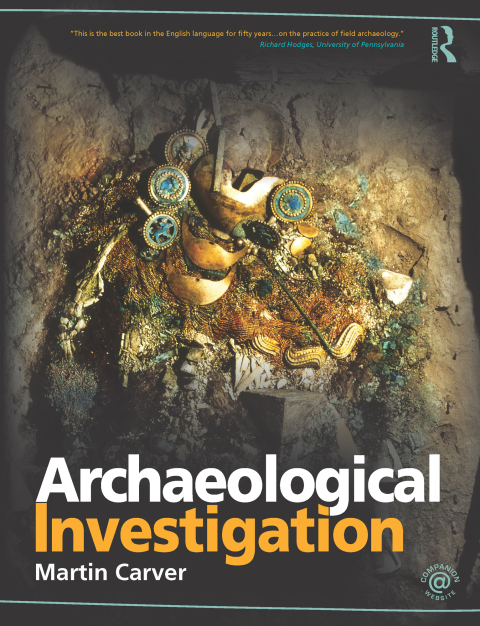Description
Efnisyfirlit
- Cover Page
- Half Title page
- Title Page
- Copyright Page
- Dedication
- Contents
- List of illustrations
- Acknowledgements and picture credits
- Preface
- Part 1 Principles
- Chapter 1 The Stuff
- A prodigious variety
- Methods of study
- Defining archaeological strata
- Archaeological vocabulary
- Conclusion
- Briefing
- Chapter 2 Approaches
- What do we want from fieldwork?
- Empirical to reflexive: five approaches
- Evaluative archaeology
- Field Research Procedure
- Briefing
- Chapter 3 Field Research Procedure: A Framework
- A value-led project: the Sutton Hoo burial ground
- Stage 1: Reconnaissance
- Stage 2: Evaluation
- Stage 3: Project Design
- Stage 4: Implementation
- Stage 5: Analysis
- Stage 6: Publication
- Reflection
- Briefing
- Part 2 In the Field
- Chapter 4 Landscape Survey
- First day in the field
- Techniques
- Applications
- In sum …
- Briefing
- Chapter 5 Site Survey
- Looking at sites
- Techniques
- Applications
- Site survey for evaluation
- Site survey for research
- In sum …
- Briefing
- Chapter 6 Excavation
- First day on a dig
- On method: three ways of dissecting strata
- On procedure: Recovery Levels
- Recording
- The course of an excavation
- In sum …
- Briefing
- Chapter 7 Projects Galore: Integrated Field Research
- Introduction
- A cave site in Greece (FIG 7.2; no. 2 on FIG 7.1)
- A shell mound in Kentucky (FIG 7.3; no. 3 on FIG 7.1)
- On the gravels: a timber palace in northern England (FIGS 7.4, 7.5)
- On the sand: a Neolithic village by the Seine (FIG 7.6; no. 6 on FIG 7/1)
- A turf hall in Norway (FIGS 7.7 and 7.8; no. 7 on FIG 7.1)
- A stone fort in Sweden (FIG 7.9; no. 9 on FIG 7.1)
- A tell site in Syria (FIG 7.10; no. 10 on FIG 7.1)
- A terp site in Holland (FIG 7.11; no. 11 on FIG 7.1)
- A Maya ruin in Belize (FIG 7.12; no. 12 on FIG 7.1)
- A villa by the Adriatic (FIGS 7.13 and 7.14; colour plate 7; no. 13 on FIG 7.1)
- Tomb tableaux in China (Colour Plate 8a; no. 17 on FIG 7.1)
- Studying standing buildings
- Urban archaeology
- Getting wet
- In a shallow Alpine lake (FIG 7.22; no. 22 on FIG 7.1)
- Diving deep off Turkey (FIG 7.23; no. 23 on FIG 7.1)
- In sum …
- Briefing
- Part 3 Writing Up
- Chapter 8 Analysis
- The tasks: manage, assess and analyse
- The analytical programme
- Case study: Saddler Street, Durham
- Conclusion
- Briefing
- Chapter 9 Assemblage
- Retrieval
- Analysis
- Artefacts
- Biota
- Interpreting site assemblages
- Briefing
- Chapter 10 Space
- Scales of space
- Spatial patterns from excavation (FIG 10.1)
- Plotting objects
- Mapping features and structures
- Spatial patterns from site survey (FIG 10.7)
- Spatial patterns in the landscape (FIG 10.10)
- Pattern-seeking by computation
- Conclusion
- Briefing
- Chapter 11 Chronology
- The business of chronology
- Typological dating of artefacts
- Scientific dating of materials
- Using objects to date contexts
- Relative ordering of contexts
- Ordering contexts by their assemblages
- Chronology for poorly stratified sites
- The chronology of well-stratified sites
- Context seriation: Assemblages and stratification working together
- Feature sequence diagrams
- Conclusion
- Briefing
- Chapter 12 Synthesis
- Why write?
- Site models
- Interpretation
- The wider context
- Conclusion
- Briefing
- Chapter 13 Publication
- Types of output
- Archive
- Client reports
- Research reports
- Preparing a research report
- Talking to the public
- Presentation of sites
- Conclusion
- Briefing
- Part 4 Design
- Chapter 14 Project Design
- Introduction
- Field Research Procedure and its design stages
- Evaluation in town and country
- Making the resource model – rural sites
- Resource modelling for urban sites
- Contents of a Project Design
- Implementation
- Conclusion
- Briefing
- Chapter 15 Our Profession and its Context
- What sort of a state are you in?
- The research cycle
- The heritage cycle
- The creative spirit
- Briefing
- Glossary, Acronyms and Abbreviations
- Abbreviations
- Bibliography
- Index






Reviews
There are no reviews yet.